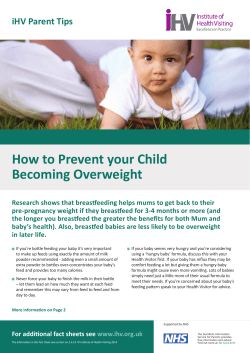
HOW TO MAKE YOUR OWN BABY FOOD
HOW TO MAKE YOUR OWN BABY FOOD Making your own baby food is a simple way of offering your baby a variety of foods. There are many benefits to making your own baby food: Less expensive Provides more variety Allows your baby to eat the same foods as your family Allows you to know what is in your baby’s food (store bought foods may have added salt, sugar, spices and other ingredients that are not needed) The texture can be modified as the baby progresses EQUIPMENT To get started, you may choose to use any of the following equipment: A potato masher or fork A fine mesh sieve or strainer A blender (tip: mason jars can fit most blenders) or a baby food mill (grinder) or a food processor FOOD SAFETY It is important to avoid any food borne illness by using proper food safety measures. Make sure to wash your hands with soap and warm water before preparing food. Ensure that the equipment and utensils are also properly sanitized. To sanitize, place equipment in your dishwasher, or fill your kitchen sink with warm water and add a cap full of bleach, soak the equipment for about 1 minute and let air dry. Suggested texture progression (based on developmental skills): Baby is able to: Sit with support Sit without support Crawl Texture Pureed, mashed foods and semi-solid foods Soft mashed foods without lumps Ground or soft mashed foods with tiny lumps, soft textured foods, crunchy foods that dissolve Walk with assistance Coarsely chopped foods, soft to moderate texture, bite-sized pieces of food, finder foods By 12 months, baby should be able to transition to the same foods as the rest of the family. Babies only need pureed foods for a short amount of time, progress to different textured foods as needed. See example below. HOW TO PREPARE There is no need to add salt, sugar, butter, spices or any other additive. Meat and alternatives Examples: chicken, pork, beef, beans, lentils, fish, whole egg, tofu. (Avoid deli meats) *Drain and rinse canned legumes before using 1. 2. 3. 4. To soften, boil, bake, stew or steam If required, remove fat and bones Cut into small pieces Mash, blend or grind. Add water or breast milk gradually to reach the texture that you want. Vegetables and fruit (fresh, frozen or canned) *Rinse canned vegetables before using 1. 2. 3. 4. Wash, peel, remove seeds, pits, and cut vegetable or fruit Cook until soft (steaming is recommended to preserve nutrients) Mash, blend or press into the strainer Add water from cooking STORING Baby food can be served as soon as it is prepared; or can be stored in the refrigerator for a maximum of 3 days. (Refrigeration slows down the growth of bacteria but does not kill bacteria.) It can also be frozen for later use for up to 2 months if stored in the refrigerator freezer, and up to 6 months if stored in a deep freezer. Foods that are prepared with infant formula should not be frozen. Freezing guidelines: 1. Portion 2 Tbsp of food into each cube in the ice cube tray or drop 2 Tbsp of food onto a baking sheet 2. Place in the freezer cover with a wax paper 3. Once frozen, put frozen food into a freezer bag 4. Write the date and the food item on the bag SERVING 1. When the food is needed, take out the amount required and defrost in the refrigerator or in a plastic bag under cold water. Do not thaw at room temperature. 2. Foods can be heated using a saucepan or a double-boiler 3. Check temperature before serving 4. Do not refreeze thawed food Content adapted from the Registered Dietitians at EatRight Ontario. For more information visit www.ontario/eatright.ca Photos: All rights reserved by Ottawa Public Health, City of Ottawa. Permission is granted to print and copy this work for educational and non- commercial purposes. No part of this information may be reproduced for any other purpose without the prior written permission of Ottawa Public Health, City of Ottawa. 1-800-563-2808
© Copyright 2025





















